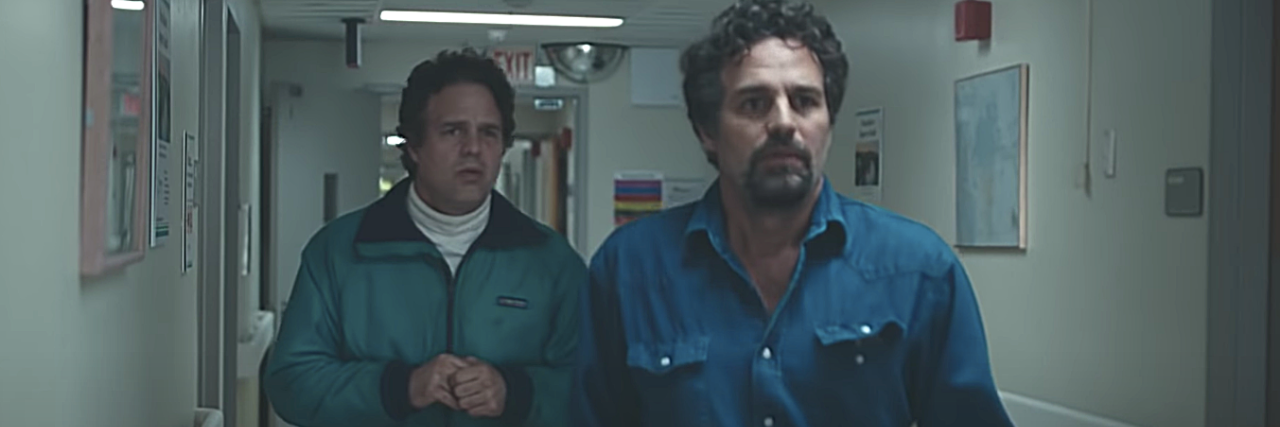Why I Almost Stopped Watching 'I Know This Much Is True' After the First Episode
Editor's Note
This story contains spoilers for HBO’s “I Know This Much Is True”
This weekend I watched the first two episodes of HBO’s limited series, “I Know This Much Is True.” The series is based on the book by Wally Lamb of the same name. The story centers around the lives of identical twin brothers, Dominick and Thomas. Dominick is the caretaker of his brother Thomas, who has schizophrenia.
I wanted to watch this series because I, too, have schizophrenia, and I need to see the illness I have lived with for over two decades portrayed in artwork and the media.
The story is told through varying timelines. We see stories of when the boys were in grade school, and the timelines span to when they are in their 40s.
The opening scene is a narration by Dominick about an incident with Thomas, one that happened in a public library when both men are approximately 40 years old. The event is one of self-mutilation. We also see an earlier time when Thomas was mad at Dominick, so he jumped out of the car and ran across several freeways in oncoming traffic. Thomas’s behavior in the first episode is childlike, with religiosity, slow speech and meltdowns.
After their mother dies, and Dominick swears to her on her deathbed to take care of Thomas, we learn part of the reason Dominick feels so responsible for his brother. From an argument between Ray (the abusive stepfather) and Dominick, it is clear that Ray believes Thomas would be fine if their mother had allowed him to raise him the way he wanted to. We learn through this same argument that Dominick believes schizophrenia, the diagnosis that Thomas has, is a genetic disorder and involves an abnormality in the brain.
Although we learn in the second episode that Thomas has lived in a psychiatric facility or group home-like setting for several years, Dominick is his caretaker in many ways. He is his brother’s advocate, involves him in family functions and stays involved with his treatment.
The second episode focuses much more on what happens to Thomas after his act of self-mutilation in the library. Thomas is committed to a forensic hospital, and Dominick tries to intervene and get him back to the facility where he is familiar. Dominick meets the social worker and the psychologist at the new facility. As Dominick battles the system, we learn a great deal about his anger, his struggles and his conflicts about his brother. At this point, he calls Thomas “an anchor” and “his curse.”
I found both episodes very difficult to watch for different reasons. As someone with a severe mental illness, I found the self-mutilation and running through traffic to be triggering for self-harm and intrusive thoughts. In scenes from when the twins are little, Ray could trigger those with the lasting trauma of an abusive parent. Also, the representation of schizophrenia in the first episode seemed off to me. It seemed like Thomas could have a multitude of disorders, and schizophrenia seemed unlikely. I say this because even during times when I was psychotic, I have been able to speak clearly. Also, there is no helping the audience understand that he may be hearing voices, which is common in schizophrenia and has been a part of almost every episode I have ever experienced.
As the first episode wraps up, we see Thomas physically restrained and committed, and Dominick tackled by security guards. I didn’t think I was going to be able to continue with the series because of the intensity of the first episode.
After a two day break for me, HBO put up the second episode, and I went back to watch it. In the second episode, I felt like it was clear that Thomas had schizophrenia because his symptoms mirrored my worst symptoms in many ways. In this episode, Thomas displays paranoia, delusions, persecution and conspiracy theories.
The representation of schizophrenia in the show so far shows the illness on one of the more extreme sides of the spectrum, as Thomas is never stable or clear thinking. But I do think it is an accurate depiction of how schizophrenia looks in some people’s lives. I happen to weave in and out of symptoms in my daily life, but Thomas seems to have constant and persistent symptoms of the illness, which is just as accurate a depiction as someone who can go years or months or weeks without symptoms.
The hardest part to watch in episode two is the collateral damage of the diagnosis of schizophrenia. It shows that the family can often try very hard and have little to no control over the treatment of their loved one, and it shows that a diagnosis of schizophrenia affects more than one person — families and loved ones are affected as well. In my case, my husband has been impacted the most by my illness, and the less than subtle reminder was heartbreaking.
I plan to watch the rest of the series. Although it is difficult to see these issues brought up and acted out, so much of it is authentic for many families, and although I don’t like to think of the illness I have as this extreme or challenging for others, the truth is it can be and is.
There are four more episodes, and they will be released one at a time on HBO on the following Sundays: May 24, May 31, June 7 and June 14.
Content Warnings: self-harm, verbal abuse, restraints in a psychiatric setting
Rating: 

